Report on Hepatitis B and C in Canada: 2013
Foreward
The Centre for Communicable Diseases and Infection Control, Public Health Agency of Canada (the Agency), is pleased to present the Report on Hepatitis B and C in Canada: 2013. This report is intended to provide information on trends in cases and rates of hepatitis B virus (HBV) and hepatitis C virus (HCV) infection to those who are concerned with the public health implications of these conditions (program managers, policy makers, researchers, etc.).
Viral hepatitis is an inflammation of the liver caused by one of the five hepatitis viruses; hepatitis B and C are the most common bloodborne hepatitis viruses and are the focus of this report. Although distinct from one another, infection with HBV and HCV can both cause either non-symptomatic or symptomatic acute infection. Infection with either virus may progress to chronic infection, and can result in severe illness and premature deathReference 1.
Both HBV and HCV infection are notifiable in Canada. The Report on Hepatitis B and C in Canada: 2013 is based on surveillance data reported to the Canadian Notifiable Disease Surveillance System (CNDSS) by provincial and territorial health authorities.
Any comments and suggestions that would improve the usefulness of future publications are appreciated and should be sent to the attention of the staff of the Centre for Communicable Diseases and Infection Control, Public Health Agency of Canada at ccdic-clmti@phac-aspc.gc.ca.
Acknowledgements
The publication of this report would not have been possible without the collaboration of epidemiological units in all provinces and territories, whose continuous contribution to national HBV and HCV surveillance is gratefully appreciated.
This report was prepared by the Centre for Communicable Diseases and Infection Control, Infectious Disease Prevention and Control Branch, Public Health Agency of Canada.
Executive Summary
This report summarizes surveillance data on cases and rates of hepatitis B virus (HBV) and hepatitis C virus (HCV) infection in Canada, reported from 2005 to 2013. Cases are reported to the Canadian Notifiable Disease Surveillance System (CNDSS) by provincial and territorial health authorities. Although not feasible for HCV due to provincial/territorial reporting practices, data for HBV are summarized separately for acute and chronic infection where possible. Information about acute HBV offers valuable insight into current transmission trends and patterns while cases of chronic HBV infection represent the potential burden of disease in Canada.
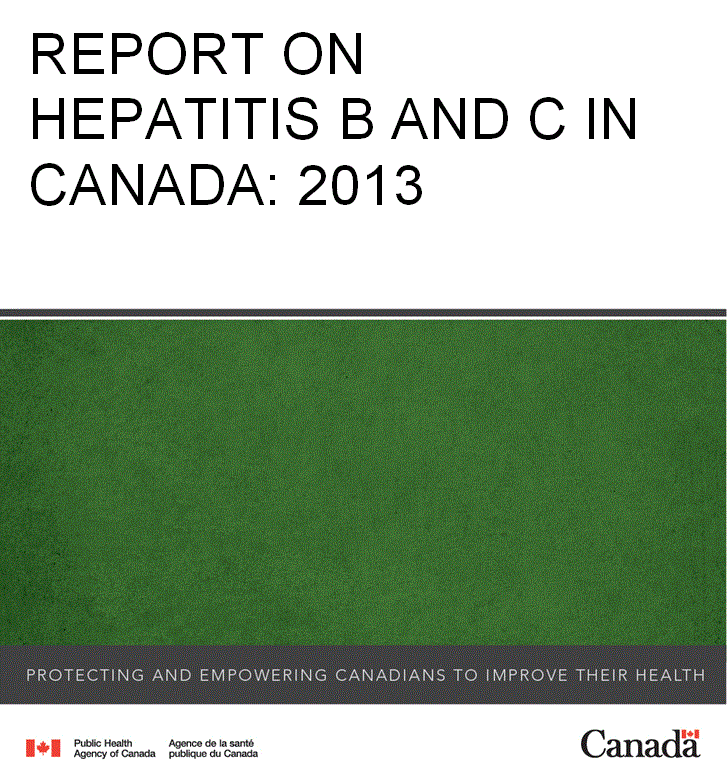
Download the alternative format
(PDF format, 872 KB, 38 pages)
Organization: Public Health Agency of Canada
Date published: 2016-07
Cat.: HP37-22E-PDF
ISBN: 2369-3843
Pub: 160105
Related Topics
Hepatitis B
Analysis of acute HBV data reported through the CNDSS demonstrates that acute HBV rates decreased from 1.0 to 0.5 per 100,000 between 2005 and 2013. Over this nine year time frame, acute HBV rates decreased among males of all age groups, although there was a slight increase in the 15 to 19 age group. Meanwhile, among females, acute HBV rate increases and decreases were observed in different age groups. In 2013, rates of reported cases of acute HBV ranged from 0 to 0.8 per 100,000 across all jurisdictions. Rates of reported cases above the national rate of 0.5 per 100,000 were observed in Ontario, Saskatchewan and Alberta.
For chronic hepatitis B, shorter term trends between 2009 and 2013 are presented, as reporting of chronic HBV infection was variable across provinces and territories in prior years, making interpretation of earlier trends difficult. Between 2009 and 2013, the rate of reported cases of chronic HBV decreased from 13.6 to 12.0 per 100,000. Overall in 2013, the rates of chronic HBV were higher in males than in females, except in those 20 to 24 years and 25 to 29 years, where rates were higher in females. The highest rates of reported cases of chronic HBV in 2013 were observed among males in the 30 to 39 age group, followed by females in the 25 to 29 age group (29.3 and 25.7 per 100,000, respectively). In 2013, chronic HBV rates above the national average of 13.0 per 100,000 were observed in British Columbia (23.4 per 100,000), in Ontario (15.1 per 100,000) and in Alberta (14.6 per 100,000).
Various potential factors may explain the trends described in this report. For example, Canada’s universal immunization program targeted at newborns and/or school-age children and, in some jurisdictions, high-risk populations, has likely contributed to declining rates of acute HBV. Other public health and infection control interventions aimed at preventing transmission of sexually transmitted and bloodborne infections may also have impacted observed trends.
National HBV rates are heavily influenced by variations in temporal and geographical reporting practices and should therefore be interpreted with caution. Provinces and territories differ in their capacity to distinguish HBV cases by infection status; as a result, HBV reporting is not uniform across the country and many hepatitis B cases are reported as unspecified. Moreover, the rates presented in this report likely underestimate the true burden of infection in Canada as HBV infection is asymptomatic in most individuals, who therefore may not present to a health care practitioner for testing.
Hepatitis C
Between 2005 and 2013, the rate of reported cases of hepatitis C decreased steadily from 40.3 per 100,000 to 29.6 per 100,000. Rates declined among both males and females in all age groups, with the exception of small increases in males aged 20 to 24 years, 25 to 29 years and 60 years and older, and females aged 15 to 19 years, 25 to 29 years and 60 years and older. Over the nine year time frame, rates of reported cases of HCV were consistently higher in males than in females overall. In 2013, the highest rate of hepatitis C was observed among males in the 40 to 59 age group, followed by males in the 30 to 39 age group. However, in younger age groups, rates among females were marginally higher than in males. Although information on HCV infection status was not available from most provinces and territories, chronic HCV infections probably make up the majority of cases reported to the CNDSS, as acute infection is usually asymptomatic and less likely to be diagnosed. Hepatitis C rates above the national average of 29.6 per 100,000 were observed in Saskatchewan, Yukon, British Columbia, Prince Edward Island, Northwest Territories, Alberta, Nova Scotia and Ontario.
Advances in blood donation screening and infection control practices in health care settings have likely contributed to the observed reductions in rates of reported HCV cases in Canada. It is also possible that public health interventions that seek to prevent onward transmission of infection among people who use injection drugs have a significant impact on these trends.
Difficulties in ascertaining acute or chronic HCV infection status render it challenging to draw inferences about trends in either acute HCV transmission or chronic burden of infection. Likewise, the lack of risk factor data on reported HCV cases limits the explanatory power of the findings presented in this report.
National statistics and trends in HBV and HCV are used to inform public health programs, guidelines, and recommendations. Despite the limitations of the data collected by the CNDSS, the observed HBV and HCV rates and trends from 2005 to 2013 substantiate the need for continued prevention and management efforts in Canada. As reporting of acute and chronic HBV and HCV become more harmonized across the country, over time, available data will be more representative of the true burden of viral hepatitis in Canada.
Table of Contents
1.0 Methods
In Canada, surveillance of nationally notifiable infectious diseases is conducted by the Public Health Agency of Canada (the Agency) in coordination with provincial and territorial governments, which voluntarily provide non-nominal data to the Agency under formal and informal agreements. Responsibility for primary data collection of notifiable disease data falls to local public health authorities according to provincial/territorial legislationReference 2.
The Agency collects and manages data received from the provinces and territories via the Canadian Notifiable Disease Surveillance System (CNDSS). CNDSS staff validates reported data with the submitting province or territory during data processing to resolve data errors or inconsistencies and maximize accuracy. Variables submitted by all reporting jurisdictions are: age at diagnosis, year of diagnosis, province/territory of diagnosis, and sex. As such, national reporting is limited to analyses of these variables. Extracts from the CNDSS are used as the basis of national surveillance reports. The current report is based on data extracted in March 2015.
Case Definitions
Case definitions for hepatitis B and hepatitis C are available in Appendix A. Hepatitis B infection has been notifiable in Canada since 1969 and the current national case definitionReference 3 defines acute, chronic and unspecified infection status. Hepatitis C infection has been nationally notifiable since 1991. Surveillance of hepatitis C cases was phased in over time by provinces and territories, with all jurisdictions reporting cases by 1999. The current HCV case definition used for national surveillanceReference 4 defines both acute and unspecified (including chronic, resolved and indeterminate) infection status.
Data analysis
Until recently, surveillance data reported to the CNDSS by most provinces and territories did not distinguish between acute and chronic HBV infection. A number of provinces and territories began reporting acute HBV cases in 2005; however, chronic HBV infection reporting only became more consistent in 2009. In order to examine trends over time, only those provinces and territories that consistently reported acute or chronic HBV over the time frame considered were included in annual rates. Population estimates from jurisdictions not included in a particular analysis were removed from the overall denominator used to calculate national rates. Consequently, annual rates of acute HBV reported from 2005-2013 included data from British Columbia, Alberta, Saskatchewan, Manitoba, Ontario, Quebec, New Brunswick, Yukon and Northwest Territories. Annual rates of chronic HBV infection reported from 2009-2013 included data from British Columbia, Alberta, Saskatchewan, Quebec, New Brunswick and Nova Scotia. Cases not identified as either acute or chronic (i.e. unspecified HBV infection) are not included in this report. Where data for 2013 was examined independently of other reporting years, data from all submitting P/Ts were included in the calculations, which may account for slight difference between 2013 rates reported in the time trend analysis and as a stand-alone statistic. Also, at the request of Prince Edward Island, its data are suppressed in any table presenting provincial and territorial specific data where counts are less than 5, as per provincial Chief Public Health Office reporting guidelines.
Most provinces and territories confirm cases using HCV antibody testing, which does not distinguish acute from chronic, or present from resolved infection; such cases are reported as unspecified HCV. As such, HCV data presented in this report are unspecified infections, and are thus a compilation of acute, chronic and indeterminate cases.
Descriptive analysis of HBV and HCV infection by year, age group and sex was conducted using data reported to the CNDSS. Demographic patterns in age and sex were examined in HBV and HCV cases reported in 2013 to provide a more detailed snapshot of the most recent available data. Since the data from Nunavut were unavailable for 2012 and 2013, population denominators for the calculation of national rates were adjusted for these two years. Rates are given per 100,000 population. Rates, percentages, and percent change in rates were calculated using unrounded numbers, thus presented rounded numbers may differ compared to calculations based on rounded numbers and may not sum to the total. The population data source was from Statistics Canada, Demography Division, Demographic Estimates Section. The July Population Estimates were used for 2005 and 2007-2010 final intercensal estimates, 2006 and 2011 final postcensal estimates, and 2012 and 2013 updated postcensal estimates. As population denominator data have been updated, rates reported may differ from previous reports.
Data limitations
Observed trends over time must be interpreted with caution as rates based on small numbers are more prone to fluctuation over time; improved diagnostic capabilities, improved duplicate removal, shortened reporting delay and changes in reporting practices at the jurisdictional level can contribute to changes.
Adjustments made to P/T data post-validation may not be reflected in that year’s national data, but will be updated for subsequent reports. Therefore, small discrepancies between Agency and provincial or territorial numbers are expected as a result of comparing dynamic databases. Larger discrepancies may be noted where P/Ts employ an analytic strategy that is different than what is used in this report. For instance, some jurisdictions choose to report chronic and unspecified HBV cases together as one category, while unspecified cases are excluded from analysis at the national level.
Due to various reasons, no concrete inference can be made to explain differences in rates observed between P/Ts. As previously mentioned, limited risk variables are collected in the HBV and HCV surveillance at the national level; in addition, the results illustrated do not take into account the different screening programs, immunization schedules and other public health and infection control interventions implemented by each jurisdiction.
2.0 Hepatitis B
2.1 Introduction
HBV is a DNA virus of the Hepadnaviridae family that mainly infects liver cells but has also been found in a variety of tissues and organs, including kidneys, pancreas and mononuclear cells Reference 5Reference 6. Symptomatic disease resulting from acute HBV infection occurs in less than 10% of children and 30-50% of adults; symptoms may include jaundice, fatigue, loss of appetite, nausea, and joint or abdominal painReference 1. Age at exposure is a significant determinant of the likelihood of developing chronic infection, which occurs in approximately 90% of infants infected at birth, and less than 10% of adultsReference 1. Chronic HBV infection may, over time, result in liver cirrhosis, hepatocellular carcinoma, decompensated liver disease and premature deathReference 1.
Transmission of HBV occurs through contact with infected blood and body fluids, most commonly through sexual or close personal contact with an infected person, use of contaminated drug injection equipment, and vertical (mother-to-child) transmission during pregnancy or birth. The patterns of HBV transmission are somewhat different in developing and developed countries, with vertical transmission and exposure through close family contacts being of significant importance in developing countries, while sexual transmission and injection drug use are the predominant patterns in developed countries such as CanadaReference 7 Reference 8. HBV can survive outside the body for up to seven days and has been implicated in both nosocomial transmission (via contaminated medical or dental equipment) and occupational exposure among health care workersReference 9.
Diagnosis of HBV requires laboratory confirmation via a blood sample to differentiate HBV infection from other types of hepatitis. Infection markers present in the blood can also be used to distinguish between acute and chronic HBV infection. Acute HBV infection is characterized by the presence of the hepatitis B surface antigen (HBsAg) and immunoglobulin M antibodies to the hepatitis B core antigen (anti-HBc IgM). Chronic infection is characterized by the presence of antibodies to the hepatitis B core antigen (anti-HBc) and HBsAg for over six months. The presence of HBeAg, an antigen characteristic of the initial phase of acute infection and which may be present during chronic infection, indicates that the infected individual is highly contagiousReference 10Reference 11. In contrast, anti-HBe appears during recovery from acute infection and its presence during chronic infection generally indicates reduced viral replication and low infectivityReference 11.
A vaccine against hepatitis B has been available globally since 1982Footnote 9. In Canada, all provinces and territories have had a universal newborn and/or childhood HBV vaccination program since the 1990s, although programs vary by jurisdiction with respect to the recommended dosages and schedules as well as the age groups targetedReference 11 Reference 12. In addition, some jurisdictions offer HBV vaccine to individuals who are at increased risk of infection (e.g. people who inject drugs or who engage in high-risk sexual practices)Reference 13. The National Advisory Committee on Immunization recommends routine testing for HBsAg during pregnancy or at the time of delivery; infants born to infected mothers are put on an immediate immunization schedule in an effort to reduce risk of HBV infectionReference 14.
There is no treatment for acute HBV infection; care is focused on alleviating symptoms, preventing hepatic complications and reducing the spread of infection through counselingReference 9Reference 11. Among persons with chronic HBV, interferon injections and antiviral medications are the approved treatments to prevent the development of cirrhosis, liver failure and liver cancer. However, only some individuals with chronic HBV are eligible for treatment depending on age, concentrations of serum aminotransferase and DNA HBV, and severity of liver diseaseReference 11.
2.2 National trends
Acute Hepatitis B
This section of the report presents the rates and trends of acute HBV infection in Canada between 2005 and 2013. In order to provide consistent time trends, only those provinces and territories that provided data on acute HBV infection throughout this time frame are included in national acute HBV rates, with denominators adjusted accordingly.
Trends over time
The total rate of reported cases of acute HBV infection decreased steadily between 2005 and 2013. In 2005, a total of 304 cases of acute HBV infection were reported, corresponding to an overall rate of 1.0 per 100,000, as compared to in 2013, where 178 cases were reported, which represents a rate of 0.5 per 100,000 (Figure 1).
Between 2005 and 2013, rates of reported cases of acute HBV were consistently higher among males than females, although the gap between sexes narrowed over time, as males experienced a greater decrease in rates (by 52.0% versus 31.4% for females) (Figure 1).
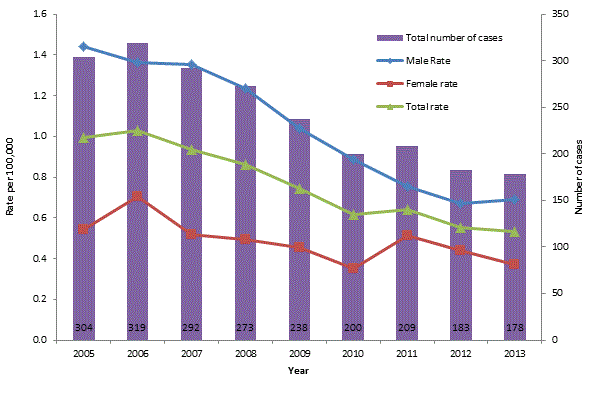
Figure 1 - Text Equivalent
| Year | Total number of cases | Total rate per 100,000 | Male rate per 100,000 | Female rate per 100,000 |
|---|---|---|---|---|
| 2005 | 304 | 1.0 | 1.4 | 0.5 |
| 2006 | 319 | 1.0 | 1.4 | 0.7 |
| 2007 | 292 | 0.9 | 1.4 | 0.5 |
| 2008 | 273 | 0.9 | 1.2 | 0.5 |
| 2009 | 238 | 0.7 | 1.0 | 0.5 |
| 2010 | 202 | 0.6 | 0.9 | 0.4 |
| 2011 | 209 | 0.6 | 0.8 | 0.5 |
| 2012 | 183 | 0.6 | 0.7 | 0.4 |
| 2013 | 178 | 0.5 | 0.7 | 0.4 |
Figure 1 notes
- Figure 1 note 1
-
Includes BC, AB, SK, MB, ON, QC, NB, NS, YT, NT.
Trends by age group and sex
In 2013, the highest rate of reported cases of acute HBV infection was observed among males in the 30 to 39 age group (1.5 per 100,000), followed by males in the 40 to 59 age group (1.0 per 100,000). In most other age groups, rates in males were similar to or slightly higher than in females (Figure 2).
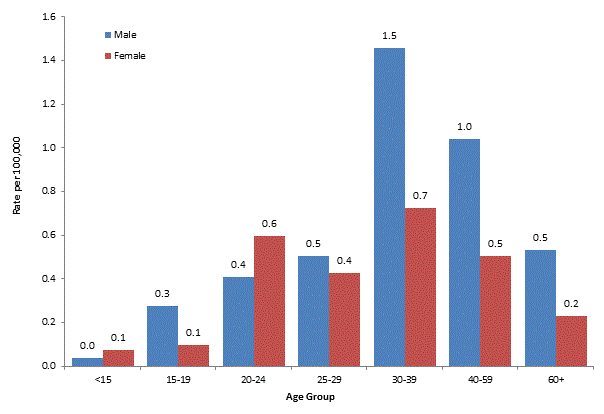
Figure 2 - Text Equivalent
| Year | 0 to 14 years | 15 to 19 years | 20 to 24 years | 25 to 29 years | 30 to 39 years | 40 to 59 years | 60+ years |
|---|---|---|---|---|---|---|---|
| 2005 | 0.1 | 0.2 | 1.0 | 1.1 | 3.1 | 2.2 | 0.9 |
| 2006 | 0.1 | 0.5 | 0.7 | 1.8 | 2.5 | 2.2 | 0.8 |
| 2007 | 0.2 | 0.2 | 1.0 | 1.5 | 2.6 | 2.1 | 0.8 |
| 2008 | 0.2 | 0.6 | 1.0 | 1.2 | 1.8 | 1.9 | 1.0 |
| 2009 | 0.0 | 0.1 | 0.4 | 0.7 | 1.2 | 1.6 | 0.9 |
| 2010 | 0.1 | 0.1 | 0.4 | 0.7 | 1.2 | 1.6 | 0.9 |
| 2011 | 0.0 | 0.1 | 0.5 | 1.0 | 1.3 | 1.2 | 0.6 |
| 2012 | 0.1 | 0.1 | 0.0 | 1.0 | 1.5 | 0.9 | 0.5 |
| 2013 | 0.0 | 0.3 | 0.4 | 0.5 | 1.4 | 1.0 | 0.5 |
Figure 2 notes
- Figure 2 note 1
-
Includes BC, AB, SK, MB, ON, QC, NB, NS, YT, NT.
Among males, the rates of reported cases of acute HBV decreased across most age groups between 2005 and 2013. In males less than 20 years of age, rates were consistently less than 1.0 per 100,000 throughout this time period. In 2005, males 30 to 39 years had the highest rate of reported acute HBV infection at 3.1 per 100,000; by 2013, this rate had decreased to 1.4 per 100,000. A decrease in rates was also observed among males 40 to 59; from 2005 to 2013 rates of acute HBV infection decreased from 2.2 to 1.0 per 100,000 (Figure 3).
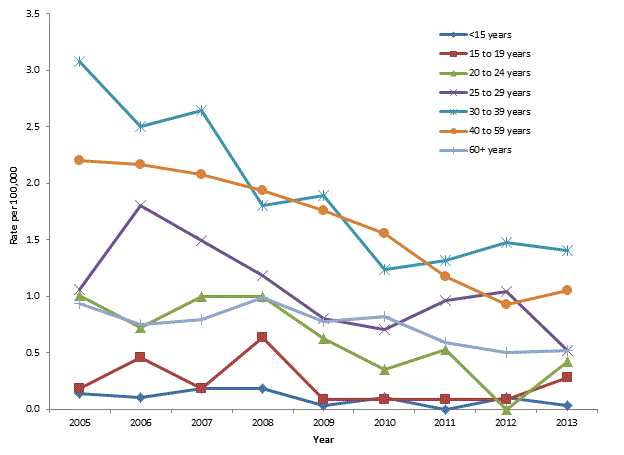
Figure 3 - Text Equivalent
| Year | 0 to 14 years | 15 to 19 years | 20 to 24 years | 25 to 29 years | 30 to 39 years | 40 to 59 years | 60+ years |
|---|---|---|---|---|---|---|---|
| 2005 | 0.0 | 0.0 | 1.3 | 1.4 | 0.9 | 0.6 | 0.2 |
| 2006 | 0.1 | 0.4 | 1.1 | 1.3 | 1.1 | 0.8 | 0.6 |
| 2007 | 0.0 | 0.0 | 1.0 | 1.0 | 0.9 | 0.6 | 0.4 |
| 2008 | 0.2 | 0.3 | 0.8 | 0.6 | 0.6 | 0.8 | 0.2 |
| 2009 | 0.2 | 0.2 | 0.6 | 0.4 | 0.9 | 0.4 | 0.2 |
| 2010 | 0.0 | 0.2 | 0.5 | 0.4 | 0.9 | 0.4 | 0.2 |
| 2011 | 0.0 | 0.3 | 0.3 | 1.4 | 1.0 | 0.6 | 0.3 |
| 2012 | 0.0 | 0.0 | 0.4 | 1.1 | 0.9 | 0.5 | 0.3 |
| 2013 | 0.1 | 0.1 | 0.5 | 0.4 | 0.7 | 0.5 | 0.2 |
Figure 3 notes
- Figure 3 note 1
-
Includes BC, AB, SK, MB, ON, QC, NB, NS, YT, NT.
Between 2005 and 2013 among females, most changes in the rates of reported cases of acute HBV were marginal, with fluctuations from year to year. More notable trends were observed among those in the 25 to 29 age group who experienced a rate decrease of 68.4% (from 1.4 to 0.4 per 100,000), and the 20 to 24 age group who experienced a rate decrease of 58.3% (from 1.3 to 0.5 per 100,000) (Figure 4).
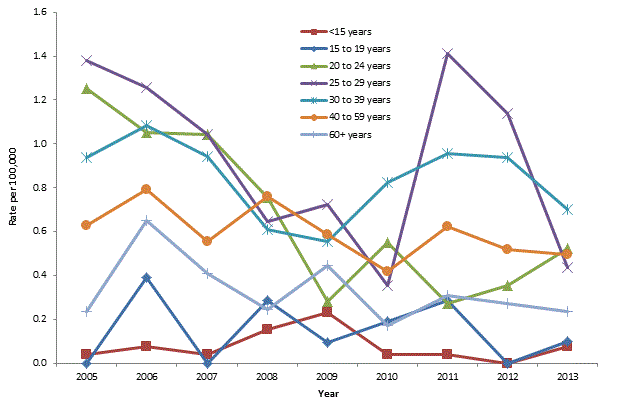
Figure 4 - Text Equivalent
| Age group | Male | Female |
|---|---|---|
| 0-14 | 0.1 | 0.0 |
| 15-19 | 0.3 | 0.1 |
| 20-24 | 0.4 | 0.5 |
| 25-29 | 0.5 | 0.4 |
| 30-39 | 1.4 | 0.7 |
| 40-59 | 1.0 | 0.5 |
| 60+ | 0.5 | 0.2 |
Figure 4 notes
- Figure 4 note 1
-
Includes BC, AB, SK, MB, ON, QC, NB, NS, YT, NT.
Trends by province/territory
In 2013, rates of reported cases of acute HBV were low in all jurisdictions (Table 1). Ontario, Saskatchewan and Alberta reported acute HBV rates above the national average of 0.5 per 100,000 (0.8, 0.7, and 0.7 per 100,000, respectively). Rates among males were consistently higher or equal to those of females across all provinces and territories (Table 1).
| Jurisdiction | Male | Female | Total | |||
|---|---|---|---|---|---|---|
| Number of cases | Rate per 100,000 | Number of cases | Rate per 100,000 | Number of cases | Rate per 100,000 | |
| Canada | 119 | 0.7 | 66 | 0.4 | 185 | 0.5 |
| BC | 10 | 0.4 | 1 | 0 | 11 | 0.2 |
| AB | 19 | 0.9 | 8 | 0.4 | 27 | 0.7 |
| SK | 7 | 0.6 | 0 | 0.2 | 7 | 0.4 |
| MB | 4 | 0.6 | 1 | 0.2 | 5 | 0.4 |
| ON | 62 | 0.9 | 47 | 0.7 | 109 | 0.8 |
| QC | 12 | 0.3 | 6 | 0.1 | 18 | 0.2 |
| NB | 1 | 0.3 | 0 | 0 | 1 | 0.2 |
| NS | 4 | 0.9 | 3 | 0.6 | 7 | 0.7 |
| PETable 1 footnote 2 | N/A | N/A | N/A | N/A | N/A | N/A |
| NLTable 1 footnote 2 | N/A | N/A | N/A | N/A | N/A | N/A |
| YT | 0 | 0 | 0 | 0 | 0 | 0 |
| NT | 0 | 0 | 0 | 0 | 0 | 0 |
| NUTable 1 footnote 3 | N/A | N/A | N/A | N/A | N/A | N/A |
|
||||||
Chronic Hepatitis B
Reporting of chronic HBV to CNDSS by provinces and territories has become routine only in recent years; therefore, chronic HBV data presented in the current report is for a shorter time period than for acute HBV, namely from 2009 to 2013. Analyses include only those provinces and territories that consistently provided chronic HBV data over this time frame.
Trends over time
There was some variation in the rate of reported cases of chronic HBV infection between 2009 and 2013, but the overall trend was a decrease over this timeframe. In 2009, a total of 2,542 cases of chronic HBV were reported, corresponding to an overall chronic HBV rate of 13.6 per 100,000. In 2013, there were 2,347 cases, resulting in a rate of 12.0 per 100,000. Between 2009 and 2013, chronic HBV rates were consistently higher among males as compared to their female counterparts (Figure 5).
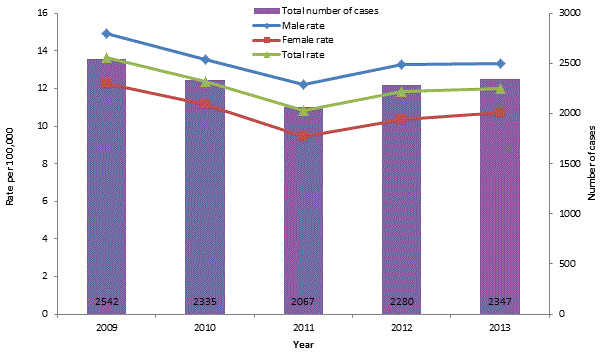
Figure 5 - Text Equivalent
| Year | Total number of cases | Total rate per 100,000 | Male rate per 100,000 | Female rate per 100,000 |
|---|---|---|---|---|
| 2009 | 2,542 | 13.6 | 14.6 | 11.4 |
| 2010 | 2,403 | 12.7 | 14.0 | 11.4 |
| 2011 | 2,176 | 11.4 | 12.8 | 10.0 |
| 2012 | 2,314 | 12.0 | 13.4 | 10.5 |
| 2013 | 2,347 | 12.0 | 13.3 | 10.7 |
Figure 5 notes
- Figure 5 note 1
-
Includes BC, AB, SK, QC, NB, NS.
Trends by age group and sex
In 2013, rates of chronic HBV for all age groups were higher in males than in females, with the exception of the 20 to 24 and 25 to 29 age groups where the reverse was found. Overall, the highest rates of reported cases of chronic HBV in 2013 were observed among males in the 30 to 39 age group, followed by females in the 25 to 29 age group (29.3 and 25.7 per 100,000, respectively) (Figure 6).
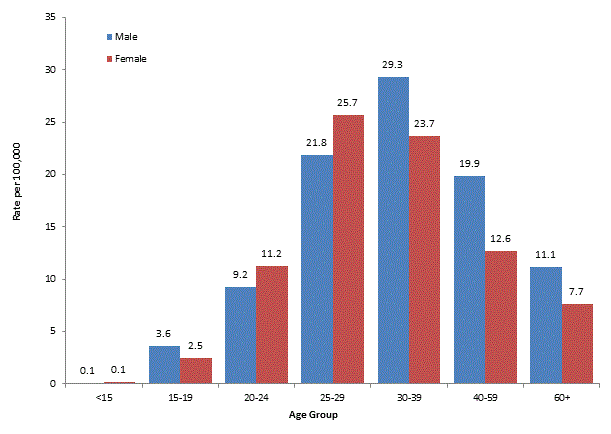
Figure 6 - Text Equivalent
| Age group | Male | Female |
|---|---|---|
| 0-14 | 0.8 | 1.0 |
| 15-19 | 4.2 | 2.5 |
| 20-24 | 7.7 | 10.8 |
| 25-29 | 17.8 | 22.8 |
| 30-39 | 26.5 | 22.5 |
| 40-59 | 18.7 | 12.2 |
| 60+ | 9.6 | 6.7 |
Figure 6 notes
- Figure 6 note 1
-
Includes BC, AB, SK, MB, ON, QC, NB, NS, YT.
Trends by province/territory
The reported number of chronic HBV cases by sex and the corresponding rates for 2013 are presented in Table 2. In 2013, British Columbia reported the highest number of cases (1,072 chronic HBV cases), also corresponding to the highest rate of chronic HBV across Canada of 23.4 per 100,000. Ontario’s and Alberta’s chronic HBV rate (15.1 and 14.6 per 100,000, respectively) were also above the national average of 13.0 per 100,000.
| Jurisdiction | Male | Female | TotalTable 2 footnote 5 | |||
|---|---|---|---|---|---|---|
| Number of cases | Rate per 100,000 | Number of cases | Rate per 100,000 | Number of cases | Rate per 100,000 | |
| Canada | 2,484 | 14.6 | 1,972 | 11.4 | 4,458 | 13 |
| BC | 539 | 23.7 | 533 | 23.1 | 1,072 | 23.4 |
| AB | 351 | 17.2 | 234 | 11.9 | 585 | 14.6 |
| SK | 52 | 9.3 | 49 | 8.9 | 101 | 9.1 |
| MB | 31 | 4.9 | 28 | 4.4 | 59 | 4.7 |
| ON | 1,150 | 17.3 | 894 | 13 | 2,046 | 15.1 |
| QC | 329 | 8.1 | 212 | 5.2 | 541 | 6.6 |
| NB | 25 | 6.7 | 18 | 4.7 | 43 | 5.7 |
| NS | 3 | 0.6 | 2 | 0.4 | 5 | 0.5 |
| PETable 2 footnote 2 | N/A | N/A | N/A | N/A | N/A | N/A |
| NLTable 2 footnote 2 | N/A | N/A | N/A | N/A | N/A | N/A |
| YT | 4 | 21.6 | 2 | 11.2 | 6 | 16.5 |
| NTTable 2 footnote 3 | N/A | N/A | N/A | N/A | N/A | N/A |
| NUTable 2 footnote 4 | N/A | N/A | N/A | N/A | N/A | N/A |
|
||||||
2.3 Discussion
Although rates of reported cases of HBV are low overall in Canada, it remains an important and preventable cause of illness and death. In 2011 (the most recent year for which mortality data were available), acute HBV infection was documented as the leading cause of 43 deaths in Canada, and a further 19 deaths were attributed to chronic HBV Reference 15. However, the true magnitude of HBV-related deaths is likely higher, due to potential misclassification on death certificates Reference 16.
Acute HBV cases offer valuable insight into current transmission trends and patterns, as cases diagnosed and reported as acute infection approximate incident cases (i.e. those that have been recently acquired). Data from the CNDSS indicate a decreases in the rates of reported cases of acute HBV infection between 2005 and 2013 in Canada, among both males and females, although rates were consistently higher among males than females over this time frame. In 2013, the rates of reported cases of acute HBV was observed among males 30 to 39 years old, followed by males 40 to 59 years old and females 30 to 39 years old.
Comparisons in acute HBV rates between Canada and other countries are limited due to differences in case definitions, reporting sources, and screening programs; however, declining rates have been similarly observed in countries with comparable population structure, health status and public health infrastructure. For example, data from routine and/or enhanced surveillance in England and the United States indicate that the annual rates of acute HBV in these countries have been decreasing over time Reference 17 Reference 18 Reference 19.
These low rates of acute HBV infection in Canada may be attributable to the implementation of routine immunization programs in all provinces and territories, starting in the early 1990s. These programs are offered to infants and/or school-aged children and, in some jurisdictions, high-risk populations Reference 13. Those who received HBV vaccine when these programs first started have now reached adulthood, and are thus highly protected from HBV infection. As an increasing proportion of the Canadian population is covered by HBV immunization, it is reasonable to expect continued decreases in acute HBV rates. In 2009, HBV immunization coverage by the second birthday was estimated to be 69% in provinces and territories with a three-dose infant programReference 20. Coverage with at least two doses of the HBV vaccine by the 17th birthday was 74.8% in 2011Reference 21. In 2012, national HBV immunization coverage was estimated at only 39.7% in the non-institutionalized adult population; however, approximately 64.9% of health care workers in close contact with patients had received the HBV vaccineReference 21.
Refinement in blood screening and improved infection prevention and control practices in health care settings have also likely contributed to Canada’s decreasing rates of acute HBV infection. Surveillance of blood donations received by the Canadian Blood Services (CBS) in 2013 indicates that HBV was detected in 47.0 per 100,000 first-time donations (which comprise less than 10% of the total overall donations), and only 2.0 per 100,000 repeat donations (i.e. donations among those who have donated previously). All donations that test positive for a transmissible disease are discardedReference 22.
Understanding the magnitude of chronic HBV infection in Canada is also important, as it represents the potential burden of disease in Canada resulting from the prolonged inability to clear the infection. Chronic HBV infection may lead to long-term sequelae such as decompensated cirrhosis and liver cancer. Data from the Canadian Organ Replacement Register (CORR) indicate that HBV was the primary diagnosis for 4.5% of liver transplant recipients in Canada from 2004 to 2013Reference 23. The majority of these transplants would have been due to chronic infection, as liver failure is a rare outcome of acute HBVReference 24. Furthermore, individuals with chronic HBV are more likely to transmit the virus to others, as compared to persons with acute HBV, as the period of communicability is relatively brief during acute infectionReference 24.
As a result of variable reporting of chronic HBV cases by provinces and territories between 2005 and 2008, analysis of chronic HBV trends over time was restricted to the time period between 2009 and 2013. Over this time frame, CNDSS data indicate that rates of reported chronic HBV cases decreased slightly. In 2013, the highest rates of reported cases of chronic HBV were observed among males in the 30 to 39 age group, followed by females in the 25 to 29 age group.
Rates of reported chronic HBV infection are higher than those of acute HBV for a variety of reasons, including probable underdiagnosis of acute cases due to their largely asymptomatic nature. In addition, chronic HBV is more likely to be diagnosed among those who were not immunized as children, as evidenced by higher rates of reported cases among those 30 years old and over, who would have been older than the recommended recipients of vaccine at the time of implementation of universal immunization programs.
There is evidence that immigration from countries where HBV is endemic also likely contributes to HBV cases reported through CNDSS, reflecting importation of cases rather than transmission of new infections in CanadaReference 25. For example, the majority of the chronic HBV infections identified in British Columbia in recent years were among persons who have emigrated from a country where HBV is endemicReference 26.
Population seroprevalence studies can help provide additional information on the burden of HBV infection in Canada. The Canadian Health Measures Survey (CHMS)Reference 27Reference 28 found the seroprevalence of current HBV infection, inclusive of both acute and chronic infection, to be 0.4% over a period of data collection spanning 2007 to 2011. Serological evidence of a previous HBV infection was identified among 4.2% of participants. Of those previously infected with HBV, 79% demonstrated complete resolution and protective immunityReference 29.
Though HBV infection rates are generally low among the general population in Canada, past research has demonstrated that certain factors are strongly associated with risk of infection, including high-risk sexual activity, injection drug use, having an HBsAg carrier as a family member, history of blood transfusion and body piercing and tattooingReference 30Reference 31. Due to such risk factors, some vulnerable populations experience higher than average rates of HBV, such as street-involved youth who may not have benefitted from provincial/territorial immunization programs despite being eligible for themReference 32Reference 33.
2.4 Limitations
There are notable limitations to the findings presented in this report. Reporting practices did not remain consistent over the time frame included in this report and, as a result, certain provinces and territories were excluded from acute and/or chronic HBV analyses. Unlike reporting of acute HBV which was more consistent over the 2005 to 2013 time frame, reporting of chronic HBV across jurisdictions between 2005 and 2013 was more variable. As a consequence, chronic HBV data received by the Agency prior to 2009 were excluded from analyses. Also of note is that it can be challenging to accurately distinguish acute from chronic HBV infection, therefore resulting in many cases to the CNDSS being reported as unspecified HBV. However, analyses presented in this report were restricted to acute and chronic HBV infection as these cases are representative of current trends in transmission and of the burden of disease.
The data are limited to analysis by age, sex, and infection status. At this time, there are no additional data elements in the CNDSS to help explain observed trends. Consequently, it is not clear what proportion of reported HBV infections are due to immigration of cases from endemic countries, injection drug use, or high risk sexual practices.
Observed trends over time may also be reflective of changes in screening practices or improved diagnostic capability, resulting in increased detection of persons with hepatitis B, many of whom likely acquired the infection well before the time of diagnosis. Additionally, these trends may be attributable to the heightened ability to distinguish acute from chronic infection; improved duplicate removal; and shortened reporting delay.
Rates based on small numbers of cases are more prone to fluctuations over time, such as acute HBV among younger females, and should be interpreted with caution. For example, the large increase in acute HBV rate observed among females in the 25 to 29 age group between 2010 and 2011 can be largely explained by the small number of cases reported in this group and the consequent potential for fluctuation in rates. The additional cases in 2011 were distributed across multiple jurisdictions and thus do not indicate any clustering in any one particular region.
Finally, the HBV rates presented in this report are likely an underestimation of the true burden of infection in Canada. As acute HBV infection is asymptomatic in over 90% of children and 50-70% of adults, the majority of individuals recently infected will not present to a health care practitioner for testing and therefore will not be reported to the CNDSS as an acute case of HBV. Results from the 2007 to 2009 and 2009 to 2011 CHMS suggest that more than half of the survey participants with laboratory-confirmed HBV were unaware of their infections Reference 29. The burden of chronic HBV in Canada is underestimated in this report due to the unavailability of chronic HBV data from Ontario for the time frame presented. A significant proportion of the Canadian population reside in the province, many of whom are immigrants from countries where HBV is endemicReference 27. A recent assessment of liver disease conducted by the Canadian Liver Foundation estimated that approximately 50% of individuals with chronic HBV in Canada reside in OntarioReference 24. Additionally, HBV infection often occurs in hard-to-reach populations who may not have access to a trusted health care provider or who may exhibit low health care seeking behaviour. Finally, though in some instances a reported acute case may become a carrier at a later time, this was not assessed in the present report and data provided to the Agency by provinces and territories were considered final for the respective reporting year.
2.5 Conclusion
Although there are limitations to available data, the findings presented in this report help address a significant knowledge gap and are useful for detecting major trends in acute and chronic HBV in Canada. Canada continues to have a downward trend in HBV rates across Canada, most notably in acute HBV cases.
Given the potential for HBV infection to progress to more serious sequelae, such as cirrhosis, hepatocellular carcinoma and liver decompensation, and the consequent potential for strain on Canada's health care system, continued monitoring of HBV is essential. Surveillance data are used to inform the development of public health programs, guidelines, and recommendations. The Agency released a primary care reference guide for the management of hepatitis B in 2013Reference 11, and provides recommendations on the use of HBV vaccine in the Canadian Immunization GuideReference 13. In future, increasing national capacity to differentiate between acute and chronic HBV will facilitate a more thorough understanding of trends in transmission and of the burden of HBV infection in Canada and further contribute to public health actions.
3.0 Hepatitis C
3.1 Introduction
HCV is an enveloped, single-stranded linear RNA virus belonging to the Flaviviridae family. Six genotypes of the virus have been identified, though genotype 1 is the predominant strain in CanadaReference 34. Those with acute HCV infection are commonly asymptomatic, which poses a challenge for identifying new cases. Approximately 15% to 50% of individuals will spontaneously clear and recover from their infection. Spontaneous clearance has been found to occur more often among those who experience symptomatic HCV infection, which is thought to signal a more robust immune responseReference 35. Approximately 50% to 85% of those with persistent HCV will progress to chronic infection and will remain asymptomatic for decadesReference 32.
HCV is highly transmissible, spreading through contact with infected blood. While many people were infected through blood and blood products in the past, the majority of HCV infections in Canada now occur through the sharing of drug preparation and injection materials (e.g., syringe, needle, cooker, water, filter, etc.). Less common routes of HCV transmission include spread through the sharing of sharp instruments and personal hygiene equipment with an infected person (e.g., razors, toothbrushes, scissors and nail clippers), as well as equipment for snorting or smoking drugs (straws, pipes, etc). Sexual transmission is thought to be rare in general, although HIV-positive men who have sex with men appear to be at elevated risk of contracting HCV in this wayReference 36. Vertical transmission from mother to child has also been documentedReference 37Reference 38.
There is no vaccine for HCV and treatment has been limited until recent yearsReference 39Reference 40Reference 41. Treatment is combined with other interventions to reduce disease progression and secondary transmission, including restriction of alcohol use and other risky practices, hepatitis A and B immunization, and treatment of co-infections. Early diagnosis and treatment reduce the likelihood of liver damage, help prevent further transmission and could, for some, help clear the virusReference 41Reference 42Reference 43Reference 44Reference 45Reference 46.
3.2 National Trends
Trends over time
Between 2005 and 2013, the rate of reported cases of hepatitis C decreased steadily among both males and females, and appears to be stabilizing in recent years (Figure 7). In 2005, a total of 12,997 cases were reported, corresponding to a hepatitis C rate of 40.3 per 100,000, compared to in 2013, when a total of 10,379 cases of hepatitis C were reported, corresponding to a rate of 29.6 per 100,000 and a 26.7% decrease from 2005. Over this time frame, rates of reported cases of hepatitis C were consistently higher among males than females. Among males, rates decreased by 29.4%, from 53.1 to 37.5 per 100,000; among females, rates decreased by 22.6%, from 27.5 to 21.3 per 100,000 (Figure 7).
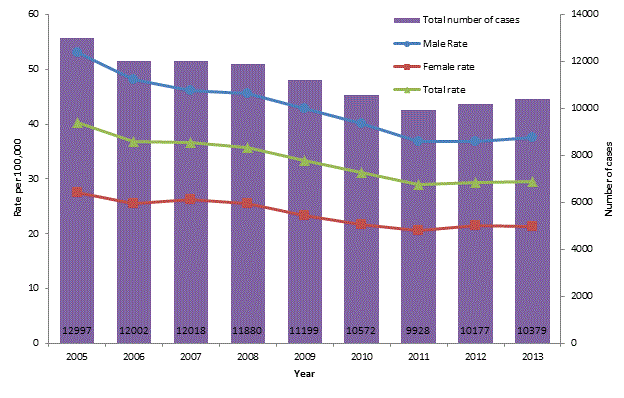
Figure 7 - Text Equivalent
| Year | Total number of cases | Total rate per 100,000 | Male rate per 100,000 | Female rate per 100,000 |
|---|---|---|---|---|
| 2005 | 13,000 | 40.4 | 53.2 | 27.5 |
| 2006 | 12,004 | 36.9 | 48.1 | 25.5 |
| 2007 | 12,021 | 36.6 | 46.2 | 26.2 |
| 2008 | 11,881 | 35.8 | 45.7 | 25.5 |
| 2009 | 11,169 | 33.2 | 42.7 | 23.3 |
| 2010 | 10,573 | 31.1 | 40.2 | 21.6 |
| 2011 | 9,923 | 28.9 | 36.8 | 20.7 |
| 2012 | 10,180 | 29.3 | 36.8 | 21.5 |
| 2013 | 10,379 | 29.6 | 37.5 | 21.3 |
Figure 7 notes
- Figure 7 note 1
-
Data for Nunavut were not available for 2012 and 2013; denominators for national rates were adjusted accordingly for these years.
Trends by age group and sex
In 2013, the highest rate of hepatitis C was observed among males in the 40 to 59 age group, followed by males in the 30 to 39 age group. For both sexes, rates were higher among those over 19 years of age. In younger age groups, rates among females were marginally higher, while males in older age groups (20 and above) exhibited substantially higher rates (Figure 8).
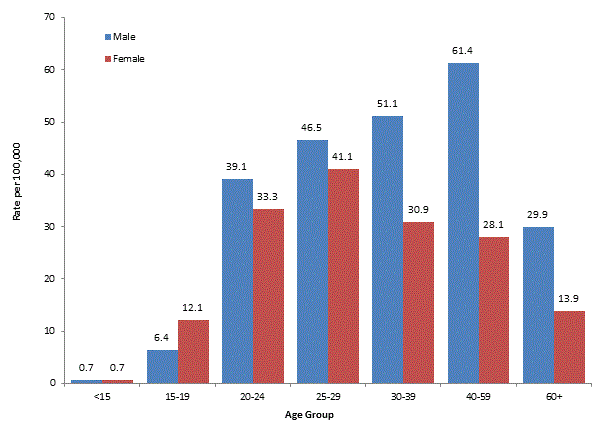
Figure 8 - Text Equivalent
| Year | 10 to 14 years | 15 to 19 years | 20 to 24 years | 25 to 29 years | 30 to 39 years | 40 to 59 years | 60+ years |
|---|---|---|---|---|---|---|---|
| 2005 | 0.6 | 6.8 | 33.2 | 56.7 | 83.9 | 101.0 | 21.8 |
| 2006 | 0.7 | 5.8 | 28.7 | 50.8 | 72.7 | 93.0 | 20.8 |
| 2007 | 0.3 | 6.7 | 29.0 | 50.6 | 68.0 | 88.1 | 22.2 |
| 2008 | 0.8 | 5.8 | 30.8 | 51.1 | 62.0 | 88.7 | 22.3 |
| 2009 | 0.5 | 5.0 | 27.8 | 50.2 | 61.1 | 81.5 | 20.4 |
| 2010 | 0.6 | 5.8 | 26.8 | 42.1 | 55.1 | 76.9 | 22.8 |
| 2011 | 0.3 | 6.0 | 23.8 | 42.6 | 50.7 | 67.2 | 24.6 |
| 2012 | 0.2 | 5.7 | 30.8 | 41.5 | 51.7 | 64.4 | 26.3 |
| 2013 | 0.7 | 6.4 | 39.1 | 46.5 | 51.1 | 61.4 | 29.9 |
Figure 8 notes
- Figure 8 note 1
-
Data for Nunavut were unavailable for 2013; the denominators for national rates were adjusted accordingly.
Between 2005 and 2013, males of all age groups experienced rate decreases, with the exception of those 60 years of age and over who experienced a rate increase from 21.8 to 29.9 per 100,000, and those 20 to 24 years who experienced a rate increase from 33.2 to 39.1 per 100,000. In 2005, males 40 to 59 years had the highest rate of reported HCV infection at 100.9 per 100,000. By 2013, this rate had decreased to 61.4 per 100,000. A large rate decrease was also observed among males 30 to 39 years of age; from 2005 to 2013 rates of HCV infection decreased from 83.7 to 51.1 per 100,000 (Figure 9).
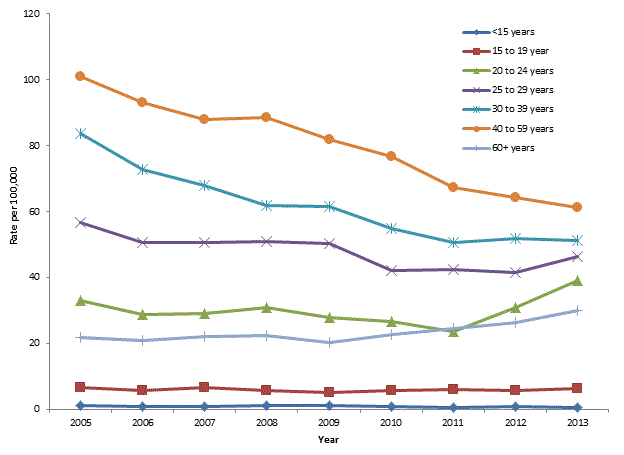
Figure 9 - Text Equivalent
| Year | 10 to 14 years | 15 to 19 years | 20 to 24 years | 25 to 29 years | 30 to 39 years | 40 to 59 years | 60+ years |
|---|---|---|---|---|---|---|---|
| 2005 | 1.2 | 13.4 | 36.6 | 35.6 | 45.6 | 40.7 | 15.9 |
| 2006 | 0.6 | 12.1 | 30.4 | 40.8 | 39.4 | 38.1 | 14.7 |
| 2007 | 0.5 | 11.8 | 31.4 | 39.7 | 40.0 | 40.7 | 14.2 |
| 2008 | 0.9 | 12.9 | 33.7 | 38.1 | 40.5 | 37.7 | 14.6 |
| 2009 | 0.7 | 13.0 | 29.9 | 36.1 | 35.1 | 35.3 | 13.0 |
| 2010 | 0.5 | 9.1 | 29.4 | 33.5 | 32.1 | 33.1 | 12.0 |
| 2011 | 0.6 | 7.9 | 27.1 | 32.0 | 31.0 | 31.4 | 12.5 |
| 2012 | 0.3 | 10.0 | 33.0 | 38.2 | 32.3 | 29.9 | 12.7 |
| 2013 | 0.7 | 12.1 | 33.3 | 41.1 | 30.9 | 28.1 | 13.9 |
Figure 9 notes
- Figure 9 note 1
-
Data for Nunavut were not available for 2012 and 2013; denominators for national rates were adjusted accordingly for these years.
Between 2005 and 2013, modest rate decreases were observed among females in most age groups, with the exception of those 25 to 29 years old who experienced a rate increase, from 35.6 to 41.1 per 100,000. Ages 15 to 19, 20 to 24 and 60 + years showed a slight increase from 2012 to 2013. A notable rate decrease of 32.3% was noted among females in the 30 to 39 age group, from 45.6 to 30.9 per 100,000 (Figure 10).
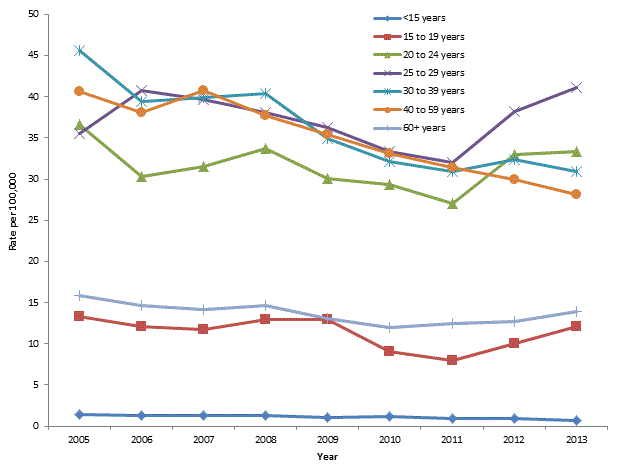
Figure 10 - Text Equivalent
| Age group | Male | Female |
|---|---|---|
| 0-4 | 1.5 | 1.5 |
| 5-9 | 0.2 | 0.2 |
| 10-14 | 0.3 | 0.4 |
| 15-19 | 6.4 | 12.1 |
| 20-24 | 39.1 | 33.3 |
| 25-29 | 46.5 | 41.1 |
| 30-39 | 51.1 | 30.9 |
| 40-59 | 61.4 | 28.1 |
| 60+ | 29.9 | 13.9 |
Figure 10 notes
- Figure 10 note 1
-
Data for Nunavut was were unavailable for 2013; the national rate denominators for national rates wereas adjusted accordingly.
Trends by province/territory
In 2013, the highest rate of reported cases of hepatitis C was observed in Saskatchewan (56.9 per 100,000). Hepatitis C rates above the national average of 29.6 per 100,000 were also observed in British Columbia, Yukon, Prince Edward Island, the Northwest Territories, Alberta, Ontario, and Nova Scotia (Table 3). Rates among males were consistently higher compared to females, across all provinces and territories, except in the Yukon, where the rate of reported HCV was higher in females than in males.
| Jurisdiction | Male | Female | TotalTable 3 footnote 3 | |||
|---|---|---|---|---|---|---|
| Number of cases | Rate per 100,000 | Number of cases | Rate per 100,000 | Number of cases | Rate per 100,000 | |
| Canada | 6,526 | 37.5 | 3,766 | 21.3 | 10,379 | 29.6 |
| BC | 1,363 | 59.9 | 741 | 32.1 | 2,105 | 45.9 |
| AB | 807 | 39.6 | 455 | 23.1 | 1,262 | 31.5 |
| SK | 370 | 66.4 | 260 | 47.3 | 630 | 56.9 |
| MB | 177 | 28.2 | 131 | 20.6 | 308 | 24.3 |
| ON | 2,605 | 39.1 | 1,548 | 22.5 | 4,156 | 30.7 |
| QC | 779 | 19.2 | 384 | 9.4 | 1,246 | 15.3 |
| NB | 119 | 31.9 | 78 | 20.4 | 197 | 26.1 |
| NS | 182 | 39.4 | 99 | 20.6 | 281 | 29.8 |
| PE | 39 | 55.1 | 19 | 25.4 | 58 | 39.9 |
| NL | 70 | 26.9 | 36 | 13.4 | 106 | 20.1 |
| YT | 7 | 37.7 | 9 | 50.5 | 16 | 44 |
| NT | 8 | 35.7 | 6 | 28 | 14 | 31.9 |
| NUTable 3 footnote 2 | N/A | N/A | N/A | N/A | N/A | N/A |
|
||||||
3.3 Discussion
Hepatitis C is a significant public health issue affecting certain segments of the Canadian population. Although rates of reported cases of HCV are on the decline overall in Canada, it remains an important cause of illness and death, and its management and treatment contributes substantially to health care system costs. In 2011, acute HCV infection was documented as the leading cause of 35 deaths in Canada, and a further 346 deaths were attributed to chronic HCVReference 15. As with HBV, there is likely considerable underestimation of the number of HCV-related deaths due to potential misclassification on death certificatesReference 47. Additionally, CORR data from 2003 to 2013 indicate that 21.2% of liver transplant recipients in Canada had a primary diagnosis of HCVReference 23. In Ontario, HCV was estimated to have the highest-ranked infectious disease burden in terms of years of life lost due to premature mortality, year-equivalents of reduced functioning, and health-adjusted life years in a 2010 studyReference 48, underscoring the impact of this infection on the health of Canadians.
This analysis summarized the recent trends in reported cases and corresponding rates of HCV in Canada using national surveillance data. Between 2005 and 2013, the rates of reported cases of HCV have declined by 26.7%; although males have consistently represented a larger proportion of reported HCV cases, particularly among those aged 30 and over, differences in male and female rates of reported HCV have narrowed since 2005.
The most important mode of transmission of HCV in Canada is the sharing of contaminated drug injection equipment. Among newly acquired HCV cases in the early 2000s with known risk factor information, 61% had reported a history of injection drug useReference 49. I-Track, the national behavioural and biological surveillance system that monitors HIV and hepatitis C and associated risk behaviours among people who inject drugs in Canada, found the lifetime exposure to hepatitis C (as measured by the presence of HCV antibody in a dried blood spot specimen) was 68% in Phase 3 of data collection conducted from 2010 to 2012Reference 50. The majority of I-Track participants (and the majority of injection drug users in general) are male which may partly explain why rates of reported HCV cases are higher among men. The higher rates of HCV case reports among females in younger age groups, and the narrowing of rates between males and females, may be explained by the greater likelihood of females in relationships that are reliant on drug exchange, being more likely to share drug-use equipmentReference 51 . Differences between males and females may also be a reflection of different serologic testing behaviours. Females are more likely to seek health care and be testedReference 52, leading to increasing reported rates of HCV detection.
Trends in HCV rates may be affected by observed changes in drug use practices; for example, increased use of smoked or snorted drugs such as crack cocaine in place of those administered primarily by injection; smoking lessens, but does not eliminate, the risk of HCV and other bloodborne infection transmissionReference 53. Public health interventions aimed at preventing adverse consequences of drug use may also have a significant effect on these trends by impacting transmission ratesReference 54.
As with HBV, changes in blood donation and infection control practices may have contributed to Canada's decreasing rates of HCV. Canadian Blood Services data from 2013 indicate that HCV was detected in 51.3 per 100,000 first-time donors, and 0.4 per 100,000 repeat donorsReference 22. Blood donation screening and disposal of positive donations are important safeguards for the prevention of transmission of bloodborne infections such as HCV.
The CHMS estimated the seroprevalence of HCV antibody (anti-HCV), a marker of lifetime exposure to the virus, to be 0.5% of the household-dwelling population in Canada over a period of data collection spanning 2007 to 2011Reference 29. However, modelled prevalence estimates, taking into account vulnerable populations not surveyed by the CHMS (such as the homeless, prison inmates, and foreign-born populations who do not speak English or French) indicate that the rate of anti-HCV in the Canadian population may be closer to 1% (plausibility range, 0.6-1.3%), with approximately 42-45% of those being unaware of their status. The prevalence of chronic HCV infection was estimated to be 0.6%Reference 55.
An additional source of HCV cases may be immigration to Canada from countries where hepatitis C infections are endemicReference 56, particularly from those regions where universal precautions to prevent the transmission of bloodborne infections are not routinely implemented. Household, vertical and sexual modes of transmission, being less common in Canada, are unlikely to contribute a significant number of cases to the national total.
While no vaccine exists, treatments are available for HCV infection. Previously, treatment was limited to pegylated interferon-α in combination with ribavirinReference 41.
Recently, highly effective direct-acting antiviral agents (DAA) were approved by Health CanadaReference 39 Reference 40 Reference 59 Reference 60 and more are in clinical developmentReference 61 Reference 62. Over time, increased availability of new treatments and implementation of other public health interventionsReference 65 may reduce transmission and affect rates of newly reported cases.
3.4 Limitations
The findings of this report need to be interpreted in light of several limitations of the data. First, the HCV case definition used for national surveillance and the reporting protocols used by provinces and territories have evolved, which may have affected case reporting over time. The case definition has consistently allowed confirmatory testing to be conducted using a second manufacturer’s enzyme immunoassay (EIA). The lower sensitivity and specificity of first and second generations of these HCV assays may have impacted the accuracy of resulting HCV surveillance data Reference 66.
It is uncertain to what extent these data reflect true HCV incidence. Those with acute HCV infection are commonly asymptomatic, and thus may not have been tested or diagnosed; as a result, CNDSS data may reflect primarily chronic cases. According to results from the CHMS, only 30% of Canadian respondents who tested positive for a current HCV infection reported having been diagnosed with HCV Reference 29. In addition, due to the long duration of infection, it is possible that an individual may be tested and diagnosed in more than one province or territory over time, and consequently counted more than once in the CNDSS dataset.
The data available from CNDSS are limited to analysis by age, sex, and province/territory. At this time, there are no additional data elements in the CDNSS that could explain observed trends. Consequently, it is not clear what proportion of reported HCV infections are due to transmission through injection drug use or other risky practices.
Finally, information on whether reported HCV cases were acute or chronic was not available from most provinces and territories, thus findings cannot comment on potential current trends in transmission or the potential burden of HCV infection in Canada.
3.5 Conclusion
The rates of new diagnoses of HCV appears to be on the decline in Canada. Given the potential for HCV infection to progress to more serious sequelae and the consequent potential burden on Canada’s health care system, continued monitoring of HCV is essential.
It is hoped that, in the future, as reporting of hepatitis C cases by stage of infection becomes more harmonized, the quality of HCV data collected through routine surveillance will improve. Surveillance, supported by research that examines factors affecting observed trends, can contribute to the development of tailored HCV interventions in Canada.
References
Appendix A: Case Definitions
| Infection status | Case definitionReference 3 |
|---|---|
Acute HBV infection |
HBsAg and anti-HBcIgM positive in the context of a compatible clinical history or probable exposure OR clearance of HBsAg in a person who was documented to be HBsAg positive within the last six months in the context of a compatible clinical history or probable exposure |
Confirmed chronic HBV infection |
a person being HBsAg positive for more than 6 months OR detection of HBsAg in the documented absence of anti-HBcIgM OR detection of HBV DNA for more than 6 months. |
Unspecified HBV infectionTable 4 Footnote 1 |
serological profile not in line with either acute or chronic case definition and HBsAg positive OR detection of HBV DNA |
|
|
| Infection status | Case definitionReference 4 |
|---|---|
Confirmed case - Acute or recent infection |
Detection of hepatitis C virus antibodies (anti-HCV) or hepatitis C virus RNA (HCV RNA) in a person with discrete onset of any symptom or sign of acute viral hepatitis within 6 months preceding the first positive HCV test AND negative anti-HAV IgM, and negative anti-HBc IgM or HBsAg tests AND serum alanine aminotransferase (ALT) greater than 2.5 times the upper normal limit OR Detection of hepatitis C virus antibodies (anti-HCV) in a person with a documented anti-HCV negative test within the preceding 12 months OR Detection of hepatitis C virus RNA (HCV RNA) in a person with a documented HCV RNA negative test within the preceding 12 months |
Confirmed case - Unspecified (including chronic and resolved infectionsTable 5 footnote 1 |
Detection of hepatitis C virus antibodies (anti-HCV) OR Detection of hepatitis C virus RNA (HCV RNA) |
| NOTE: If diagnosis is based on anti-HCV alone, it should be confirmed by HCV RNA, immunoblot, a second manufacturer's EIA, or based on an EIA signal to cut-off ratio predictive of a positive immunoblot. If HCV-RNA is used solely to confirm active infection, a repeat test is recommended. The HCV seroconversion window period is approximately 5-10 weeks. It is estimated that 30% of acute infections may be missed if anti-HCV is the only marker of infection used during this period. HCV-RNA is detectable within two to three weeks of infection and, in the context of clinical illness, can identify acute HCV infection even in the absence of anti-HCV. Table 5 footnotes
|
|
- Anti-HBc IgM
- IgM antibody against Hepatitis B core antigen.
- HBsAG
- Hepatitis B surface antigen.
- EIA
- enzyme immunoassay